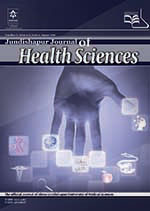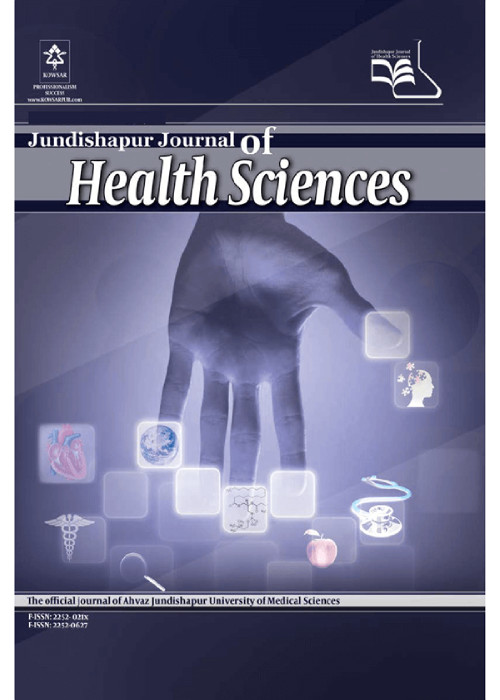فهرست مطالب

Jundishapur Journal of Health Sciences
Volume:8 Issue: 4, Oct 2016
- تاریخ انتشار: 1395/08/21
- تعداد عناوین: 8
-
-
Page 1BackgroundPhenolic compounds, phenol and phenol derivatives are environmental contaminants in some industrial effluents. Entrance of such substances into the environment causes severe environmental pollution, especially pollution of water resources. Biological treatment is a method that uses the potential of microorganisms to clean up contaminated environments. Among microorganisms, bacteria play an important role in treating wastewater contaminated with phenol.ObjectivesThis study aimed to examine the effects of Pseudomonas aeruginosa on degradation of phenol in wastewater contaminated with this pollutant.MethodsIn this method, the growth rate of P. aeruginosa bacteria was investigated using different concentrations of salt and phenol. This is an experimental study conducted as a pilot in a batch reactor with different concentrations of phenol (25, 50, 100, 150, 300 and 600 mg L-1) and salt (0%, 0.5%, 1%, 2.5% and 5%) during 9, 12 and 15 hours. During three days, from 5 experimental and 3 control samples, 18 samples were taken a day forming a sample size of 54 samples for each phenol concentration. Given the number of phenol concentrations (n = 6), a total of 324 samples were analyzed using a spectrophotometer at a wavelength of 600 nm.ResultsThe phenol concentration of 600 mg L-1 was toxic for P. aeruginosa. However, at a certain concentration, it acts as a carbon source for P. aeruginosa. During investigations, it was found that increasing the concentration of phenol increases the rate of bacteria growth. The highest bacteria growth rate occurred was at the salt concentration of zero and phenol concentration of 600 mg L-1.ConclusionsThe findings of the current study indicate that at high concentrations of salt, the growth of bacteria reduces so that it stops at a concentration of 50 mg L-1 (5%). Thus, the bacterium is halotolerant or halophilic. With an increase in phenol concentration, the growth rate increased. Phenol toxicity appears at a concentration of 600 mg L-1.Keywords: Pseudomonas bacterium, Phenol, Salt, Batch Reactor, Toxicity
-
Page 2BackgroundThe licensure is an evaluation mechanism, which allows health centers or individuals to assess health services delivery based on minimum requirements.ObjectivesThe present study aimed to audit the general practitioner (GP) offices in Tabriz city to assess their compliance with national licensure standards in 2015.MethodsThis was across-sectional study, which audited 228 general practitioner offices randomly. The data from offices was collected based on researcher-made checklist, the validity of which was approved. Firstly, descriptively analysis of data was done and then, the relationship between clinics characteristics and compliance with standards was assessed using Analysis of Variance (ANOVA) and Tukeys test. To perform the analysis, the SPSS19 software was used, and PResultsBased on the study results, the mean standards compliance in GP offices was 78.9%, with highest compliance dedicated to medical documents and informatics dimension with 99.1% compliance level and lowest compliance related to hygiene dimension with 56.2% compliance level. In the analysis of the statistical relationship between the offices characteristics and licensure standards, there was significant relationships, between daily admittance of patients in offices and standards compliance in human resources dimension; GPs job experience and standards compliance in medical and non-medical devices dimension; and urban district of office and standards compliance in physical environment dimension and medical and non-medical devices dimension. In addition, there was a significant difference between total score of standards compliance and offices of urban districts (PConclusionsGenerally, the status of Tabriz general health clinics was relatively acceptable. Thus, evaluation authorities should pay attention especially to the hygiene dimension.Keywords: Licensure, Audit, General Practitioner Offices
-
Page 3BackgroundHeat is a harmful factor in workplaces that causes physiologic and cognitive changes in workers.ObjectivesThe purpose of this study was to investigate the effect of cooling vest on heat strain and reaction time while wearing chemical-biological-nuclear protective clothes.MethodsTwelve male students with mean age of 25 ± 2 and body mass index (BMI) of 23 ± 1.5 were recruited in the experiment. Each student ran on a treadmill with a speed of 2.4 km/hour in the climate chamber at 35°C and 30% relative humidity. physiological strain index score, oral temperature, heart rate, reaction time and number of errors were measured at the end of the two levels and analyzed by the SPSS software.ResultsWilcoxon test showed that the differences of physiological strain index score (P = 0.02), oral temperature (P = 0.02), reaction time (P = 0.02), heart Rate (P = 0.02) and errors (P = 0.03) with and without the cooling vest were significant. The mean physiological strain index score without cooling vest was 4.038 ± 0.882 and with the cooling vest was 1.42 ± 0.435. The mean reaction time without and with the cooling vest was 0.769 ± 0.0972 and 0.539 ± 0.977, respectively.ConclusionsThe results of the study showed that the cooling vest reduces the physiological strain, reaction time and errors rate of workers.Keywords: Heat Strain, Reaction Time, Physiological Strain Index, Cognitive Performance
-
Page 4BackgroundIn the dairy industry, protection against species substitution or admixture is important for several reasons, including frequent human adverse reactions toward some species milk proteins, and trade and government regulations.ObjectivesThe objective of the present study was to assess the purity of buffalo milk and its products offered as pure buffalo in the market.MethodsUsing species-specific primers, a duplex polymerase chain reaction (PCR) assay was performed to detect the fraudulent addition of cows milk to buffalos milk and its products.ResultsThe limit of detection of cows milk in buffalos milk, yogurt and cheese is 1, 2 and 4%, respectively. Undeclared presence of cows milk was detected in 70% of the milk samples, 64% of the yogurt and 52% of the cheese samples. In 10% of the yogurt samples and 14% of the cheese samples, no apparent buffalo-related amplification product was observed, suggesting that cows milk was entirely substituted for buffalos milk in these samples.ConclusionsTo avoid unfair competition and to assure consumers of accurate labeling, using this method is recommended for regulatory agencies.Keywords: Milk, Cow, Buffalo, Adulteration, Species Identification, PCR
-
Page 5BackgroundTextile dyes are the largest organic compounds associated with some problems for the environment. Advanced oxidation process is the most effective method for dye removal from wastewater.ObjectivesThe aim of this study was to investigate the efficiency of the photo Fenton process for decolorization of direct red 81 (DR 81) dye, and to determine the optimal process conditions.MethodsThis is a cross-sectional study conducted on a laboratory scale. The effective parameters in the photo Fenton process include pH, ferrous sulfate heptahydrate concentration, hydrogen peroxide concentration, initial dye concentration and reaction time. These parameters were studied, and finally analyzed using the Excel software.ResultsAccording to the obtained results, maximum removal efficiency was 98.1% at pH = 3, concentration of Fe (II) was 10 mg/L, hydrogen peroxide concentration was 50 mg/L, initial concentration of dye was 100 mg/L, and reaction time was 120 minutes. Results showed that increasing the concentration of Fe (II), H2O2 and the initial concentration of dye to a certain extent resulted in increasing removal efficiency, then by increasing the concentrations of these parameters, removal efficiency decreased. Results also indicated that increasing a reaction time resulted in increasing removal efficiency.ConclusionsThe photo Fenton method with optimized parameters can be used to conduct high efficiency dye removal in a short period of time and this process is based on hydroxyl radical formation.Keywords: Industrial Wastewater, Direct Red Dye 81, Photo Fenton Process, Removal Efficiency
-
Page 6BackgroundNurses represent an important job group commonly affected by musculoskeletal disorders (MSDs). One of the main reasons is patient transfer tasks. Handling patients using a safe work technique is considered as one prevention strategy when integrated in multidimensional interventions.ObjectivesThe aim of this study was to assess the musculoskeletal disorders risks related to patient transfers in nursing personnel using the direct nurse observation instrument (DINO) method.MethodsThis cross-sectional study was conducted on 250 nurses working in affiliated hospitals of Isfahan University of Medical Sciences in 2015. Data were collected by Nordic questioners and the DINO index check list. The validity and reliability of the DINO checklist were reviewed and approved. To analyze the data, independent t- test, chi-square test and logistic regression were used.ResultsThe prevalence of MSDs was 87.6% in a 12-month period. The average result of the DINO checklist was 9.73 points (SD = 1.8), which can suggest that the way in which the technical transfer was carried out might not have been the safest. The results from logistic regression showed that the occurrence of MSDs in nursing staff was significantly associated with final scoring of the DINO index (PConclusionsAccording to the findings of the current study, DINO is an appropriate tool to assess MSDs risk due to patient handling in the nursing personnel. This method can be used in the evaluation of patient transfer educational programs and also to identify and assess an unsafe work technique used by the nurses.Keywords: Musculoskeletal Disease, Patient Transfer, Nursing Staffs, DINO Methods
-
Page 7BackgroundThe current study aimed to determine the knowledge, beliefs, and practices of nurses and nursing students for hand hygiene.Materials And MethodsThe study population consisted of 340 subjects (164 nurses and 176 nursing students). Data collection tools included the hand hygiene belief scale and the hand hygiene practices inventory (HHPI). Chi-square and independent samples T-tests were used for data analysis.ResultsThe mean scores of the HHPI were 66.36 ± 7.08 and 64.52 ± 4.90 for nurses and the students, respectively; the difference between the measures was statistically significant (PConclusionsThere was a moderate level of knowledge, practices, perceives and beliefs in nurses and students for the importance of hand hygiene. Compliance with the importance of hand hygiene in infection control is complex, and perceptual factors concerning hand hygiene, in addition to an individuals knowledge could affect the behaviors related to hand hygiene compliance.Keywords: Hand Hygiene, Hand Washing, Knowledge, Beliefs, Practices
-
Page 8BackgroundFumes released form welding activities are capable of initiating several acute and chronic respiratory effects.ObjectivesThe aim of the present study was to evaluate respiratory symptoms and spirometry parameters in welders of a steel industry.MethodsThis cross-sectional study was conducted in a steel industry and involved 60 welders and 40 non-welders. A questionnaire was used to record participants details, and to determine pulmonary function values the spirometric test was used. Pearson correlation, paired and independent t test as statistic tests were used for data analysis.ResultsComparison between pulmonary function values (PFV) showed a significant relationship between forced vital capacity (FVC), forced expiratory volume in one second (FEV1) and 25% - 75% forced expiratory flow (FEF25 - 75%) of the two groups. These values in the welder group had a significant reduction and declines were from 6 to 11 mL. Age and work experience showed a significant correlation with PFV in the two groups.ConclusionsAll workers that participated in this study were relatively young and considering them being young and not having long history of work experience, our results revealed that welders had less respiratory capacity and this was related to increasing work experience and age, but inconsistent with smoking habits of the two groups.Keywords: Welding Workers, Steel Industry, Respiratory Symptoms, Pulmonary Function Test


